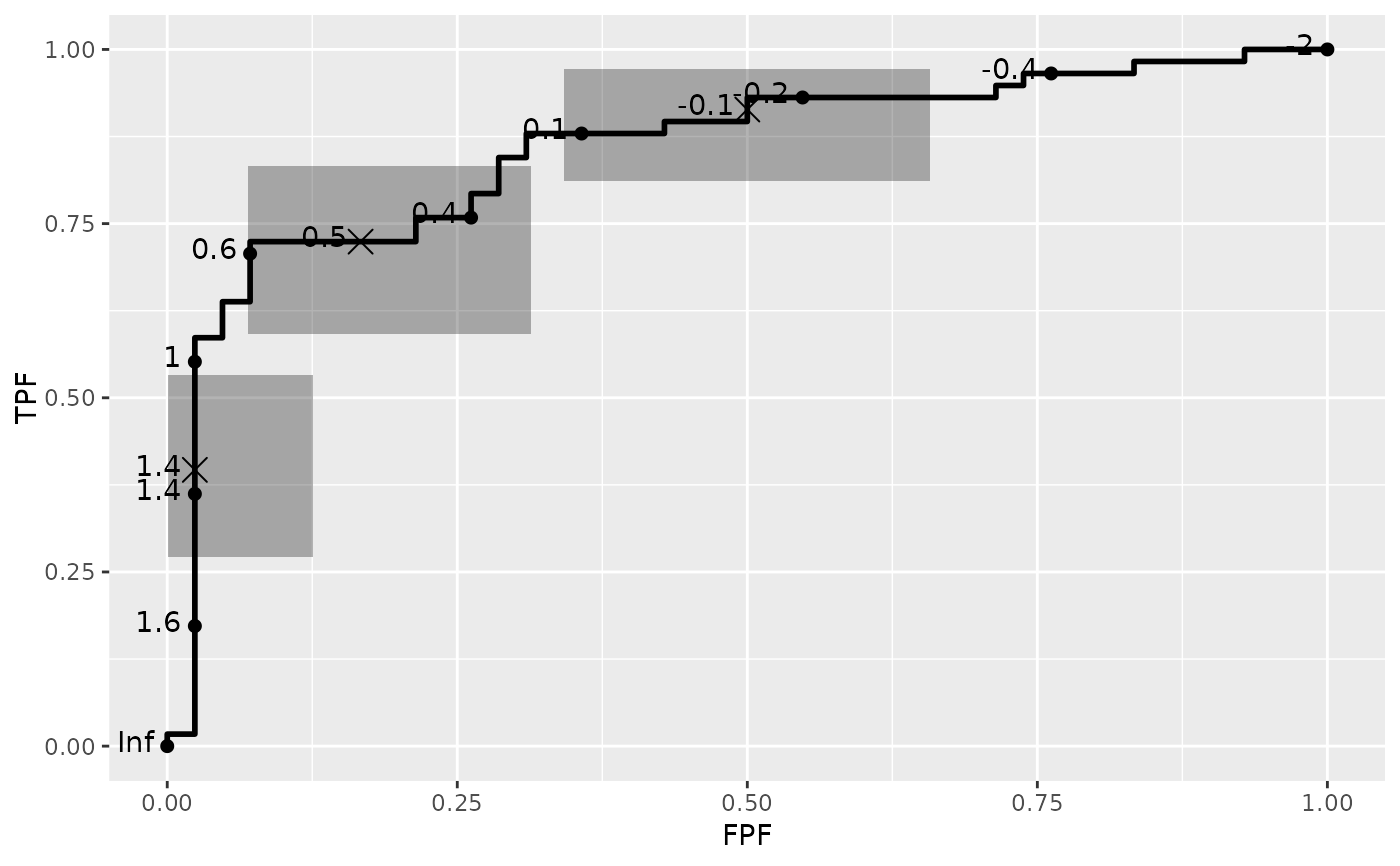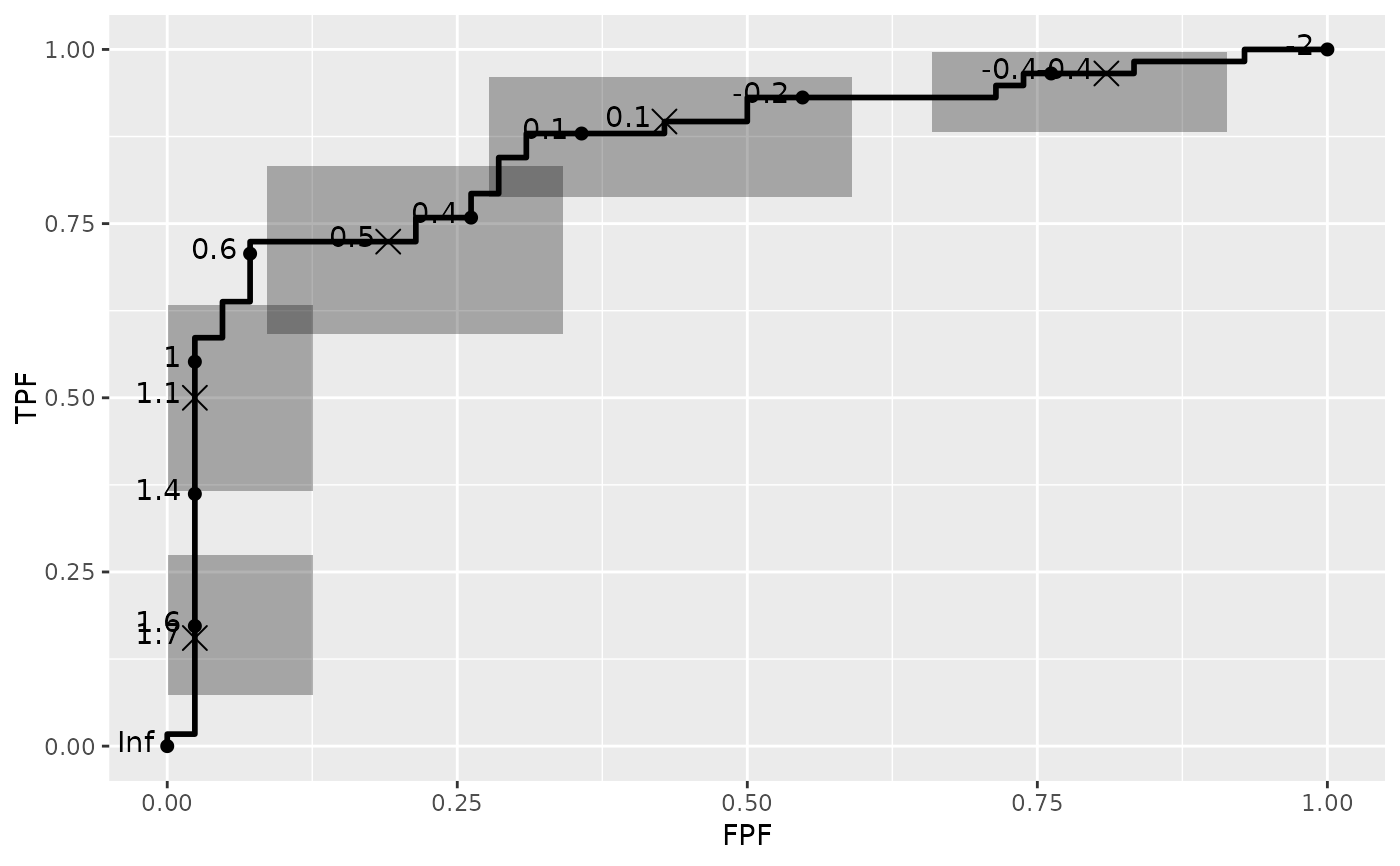Confidence intervals for TPF and FPF are calculated using the exact
method of Clopper and Pearson (1934) each at the level 1 - sqrt(1 -
alpha). Based on result 2.4 from Pepe (2003), the cross-product of these
intervals yields a 1 - alpha
Usage
StatRocci
stat_rocci(
mapping = NULL,
data = NULL,
geom = "rocci",
position = "identity",
show.legend = NA,
inherit.aes = TRUE,
ci.at = NULL,
sig.level = 0.05,
na.rm = TRUE,
...
)Arguments
- mapping
Set of aesthetic mappings created by
aes(). If specified andinherit.aes = TRUE(the default), it is combined with the default mapping at the top level of the plot. You must supplymappingif there is no plot mapping.- data
The data to be displayed in this layer. There are three options:
If
NULL, the default, the data is inherited from the plot data as specified in the call toggplot().A
data.frame, or other object, will override the plot data. All objects will be fortified to produce a data frame. Seefortify()for which variables will be created.A
functionwill be called with a single argument, the plot data. The return value must be adata.frame, and will be used as the layer data. Afunctioncan be created from aformula(e.g.~ head(.x, 10)).- geom
The geometric object to use to display the data for this layer. When using a
stat_*()function to construct a layer, thegeomargument can be used to override the default coupling between stats and geoms. Thegeomargument accepts the following:A
Geomggproto subclass, for exampleGeomPoint.A string naming the geom. To give the geom as a string, strip the function name of the
geom_prefix. For example, to usegeom_point(), give the geom as"point".For more information and other ways to specify the geom, see the layer geom documentation.
- position
A position adjustment to use on the data for this layer. This can be used in various ways, including to prevent overplotting and improving the display. The
positionargument accepts the following:The result of calling a position function, such as
position_jitter(). This method allows for passing extra arguments to the position.A string naming the position adjustment. To give the position as a string, strip the function name of the
position_prefix. For example, to useposition_jitter(), give the position as"jitter".For more information and other ways to specify the position, see the layer position documentation.
- show.legend
logical. Should this layer be included in the legends?
NA, the default, includes if any aesthetics are mapped.FALSEnever includes, andTRUEalways includes. It can also be a named logical vector to finely select the aesthetics to display. To include legend keys for all levels, even when no data exists, useTRUE. IfNA, all levels are shown in legend, but unobserved levels are omitted.- inherit.aes
If FALSE, overrides the default aesthetics, rather than combining with them.
- ci.at
Vector of cutoffs at which to display confidence regions. If NULL, will automatically choose 3 evenly spaced points to display the regions
- sig.level
Significance level for the confidence regions
- na.rm
Remove missing observations
- ...
Other arguments passed on to
layer()'sparamsargument. These arguments broadly fall into one of 4 categories below. Notably, further arguments to thepositionargument, or aesthetics that are required can not be passed through.... Unknown arguments that are not part of the 4 categories below are ignored.Static aesthetics that are not mapped to a scale, but are at a fixed value and apply to the layer as a whole. For example,
colour = "red"orlinewidth = 3. The geom's documentation has an Aesthetics section that lists the available options. The 'required' aesthetics cannot be passed on to theparams. Please note that while passing unmapped aesthetics as vectors is technically possible, the order and required length is not guaranteed to be parallel to the input data.When constructing a layer using a
stat_*()function, the...argument can be used to pass on parameters to thegeompart of the layer. An example of this isstat_density(geom = "area", outline.type = "both"). The geom's documentation lists which parameters it can accept.Inversely, when constructing a layer using a
geom_*()function, the...argument can be used to pass on parameters to thestatpart of the layer. An example of this isgeom_area(stat = "density", adjust = 0.5). The stat's documentation lists which parameters it can accept.The
key_glyphargument oflayer()may also be passed on through.... This can be one of the functions described as key glyphs, to change the display of the layer in the legend.
Aesthetics
stat_rocci understands the following aesthetics (required aesthetics
are in bold):
mThe continuous biomarker/predictordThe binary outcome, if not coded as 0/1, the smallest level in sort order is assumed to be 0, with a warningalphacolorfilllinetypesize
Computed variables
- FPF
estimate of false positive fraction
- TPF
estimate of true positive fraction
- cutoffs
values of m at which estimates are calculated
- FPFL
lower bound of confidence region for FPF
- FPFU
upper bound of confidence region for FPF
- TPFL
lower bound of confidence region for TPF
- TPFU
upper bound of confidence region for TPF
References
Clopper, C. J., and Egon S. Pearson. "The use of confidence or fiducial limits illustrated in the case of the binomial." Biometrika (1934): 404-413.
Pepe, M.S. "The Statistical Evaluation of Medical Tests for Classification and Prediction." Oxford (2003).
Examples
D.ex <- rbinom(50, 1, .5)
rocdata <- data.frame(D = c(D.ex, D.ex),
M = c(rnorm(50, mean = D.ex, sd = .4), rnorm(50, mean = D.ex, sd = 1)),
Z = c(rep("A", 50), rep("B", 50)))
ggplot(rocdata, aes(m = M, d = D)) + geom_roc() + stat_rocci()
 ggplot(rocdata, aes(m = M, d = D)) + geom_roc() +
stat_rocci(ci.at = quantile(rocdata$M, c(.1, .3, .5, .7, .9)))
ggplot(rocdata, aes(m = M, d = D)) + geom_roc() +
stat_rocci(ci.at = quantile(rocdata$M, c(.1, .3, .5, .7, .9)))
